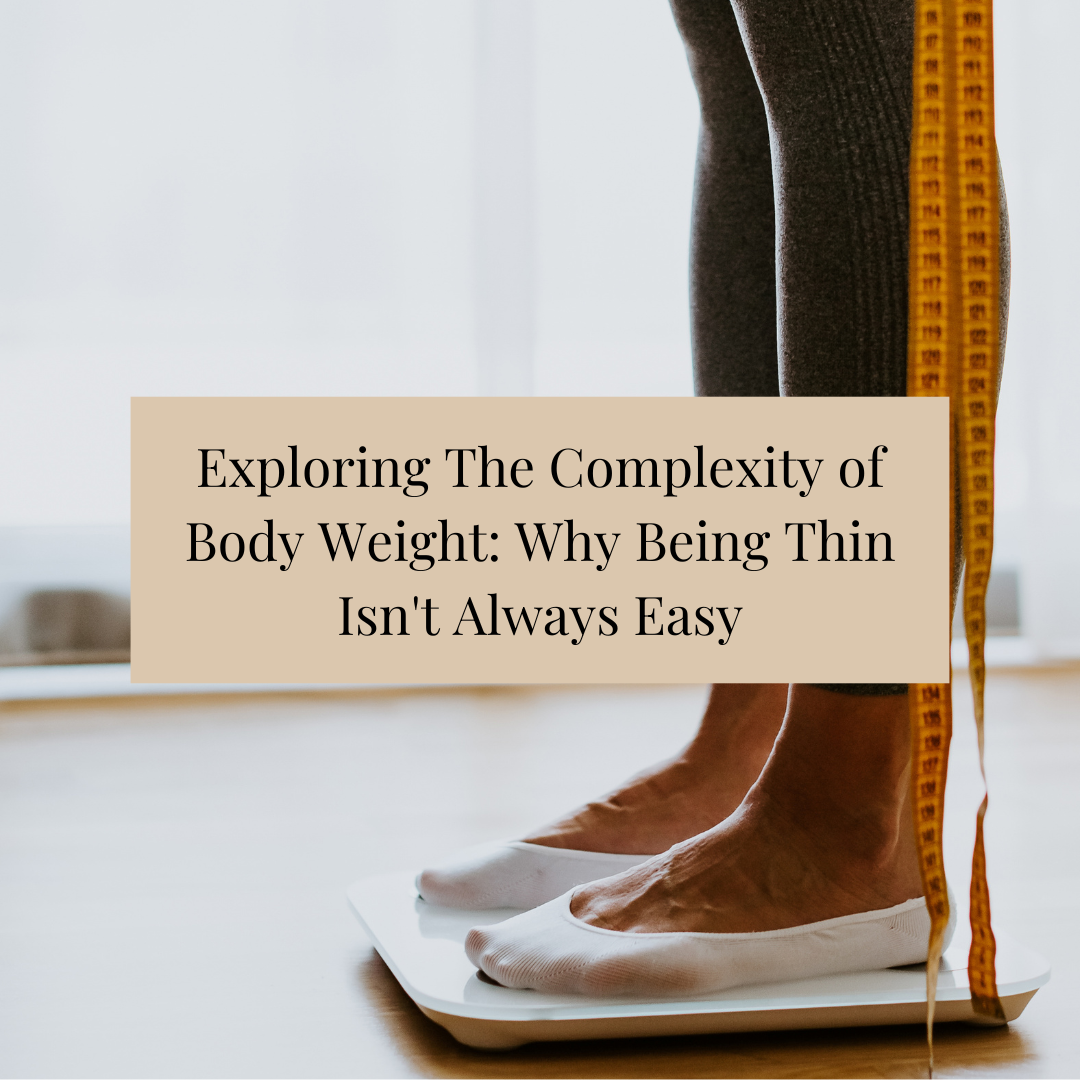A Snickers a Day Keeps the Cravings Away: A Case for Flexible Dieting
Introduction
A little over two months ago, I came up with the idea of eating a full-size Snickers bar everyday.
It started out as a joke at first. I was brainstorming a list of topics to write and/or produce a video log about, and I was thinking of ways that I could send a powerful message through my next bikini prep. What could I do through the next 10 weeks leading up to my national-level bodybuilding show to hammer home a point that I’ve been trying to communicate to the world? Naturally, I thought of flexible dieting. Despite its growing popularity in recent years, the concept is still wildly misunderstood and met with skepticism.
As a role model and educator in the health and fitness industry, I believe that it’s important to not only walk the walk but also constantly experiment and test different training and nutrition methods on myself. This, I’ve found, is the best way for me to learn, and in turn, become better equipped to then turn around and effect positive change in others.
The next thing I knew, I was driving to the grocery store and picking up my first six-pack of Snickers bars.
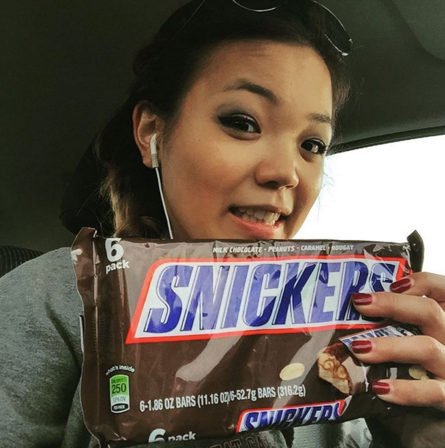
Methods
At the beginning of my prep, my stats were as follows: 25 years old, 5’2″ in height, 110lbs bodyweight, 25.0-inch waist. My job was sedentary, and I lived a lightly active lifestyle. I had over 7.5 years of resistance training experience and was familiar with proper form with the main compound movements.
My junk food of choice had to meet three criteria for this experiment:
- It had to be widely recognized by all as a treat with the general consensus that said treat had little nutritional value. I couldn’t choose an obscure brand of chocolate only available in select stores in specific countries, and I couldn’t opt for something like a protein bar that some might qualify as partially healthy.
- It had to taste good to me. I knew that if it was something that I didn’t genuinely enjoy consuming, I would quickly get sick of it and jump ship on the experiment prematurely.
- It had to be convenient and portable. With numerous work-related travels coming up, ice cream wouldn’t work. I needed to be able to chuck the treat into my purse and go on my merry way.
It didn’t take long for me to settle on Snickers.
It was important that I think and act like a scientist throughout the duration of this experiment, and this meant controlling for as many variables as possible. To that end, I was meticulous about tracking and adhering to a prescribed set of macronutrient numbers, exercising regularly, managing my sleep and stress levels, and consuming roughly equal quantities of water and sodium everyday.
Exercise
As far as my exercise regimen, my trainer Bret Contreras wrote me a four-days-a-week strength training program with an emphasis on compound movements. I performed squats, deadlifts, bench presses, hip thrusts, and pull-ups through a multitude of rep ranges, and also added in assistance work such as chest-supported rows, lunges, and lateral raises. With each workout, I was to employ progressive overload, which is another way of saying doing more over time. That meant I always made it a point to either get in an extra rep within the prescribed rep range, increase weight, and/or use better form. (See related: What is Progressive Overload?)
Utilizing this approach rather than simply going through the motions in the gym ensured that I maintained as much muscle mass as possible throughout the fat loss process. In other words, I lifted heavy weights because what builds the muscle keeps it(Hunter et al., 2008).
At the end of every workout, I also sprinkled in 10 minutes of glute work, usually using a combination of bodyweight, minibands, and long bands. The purpose of this was to help shape the glutes and provide some conditioning work without running myself into the ground.
Here is an example of the kinds of glute circuits I would do:
No formal cardio was performed throughout the duration of this prep. I did not do traditional steady-state cardio, nor did I engage in high intensity intervals of any kind. Low-intensity leisure walking was performed two to three evenings per week.
In total, I exercised four days a week for approximately one hour each session and took three full rest days per week.
Nutrition
I used a flexible dieting macros-based approach for my nutrition. In other words, I adhered to a prescribed set of macronutrient numbers (specific grams of protein, carbohydrates, and fats tailored to my unique needs) and, though I relied primarily on whole, nutrient-dense foods, I also made room to fit in a small portion of junk food here and there. (See related: This is What Flexible Dieting Actually Looks Like)
The daily Snickers bar, of course, was a constant. I made it a point to eat one every single day no matter what, usually paired with a protein source.
On days that I resistance trained, I consumed higher carbohydrates and lower fats; on rest days, I consumed lower carbohydrates and higher fats. There was no difference in total calories between my training days and rest days.
The only variable that changed throughout the 10 weeks was my total calorie intake, which was gradually reduced over time.
At week 0, my daily target calorie intake was 1560, with a 2,300-calorie refeed day strategically implemented every 10 days. I continued in this manner through week 4, after which point I dropped my calories to 1460 for week 5, 1350 for week 6, and 1280 for weeks 7 through 10 with a refeed day still tossed in once every 10 days.
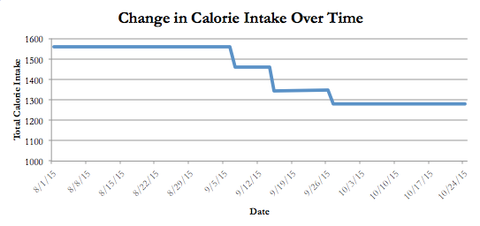
The MyMacros+ iPhone app was used to track my daily macronutrient intake. A food scale was used to increase the accuracy of my nutrition logging.
Besides meeting my macros within +/-5g of each prescribed number everyday, I also did the following:
I planned out the next day’s meals the night before. The Snickers bar was always plugged into my meal plan first, and everything else was planned around it. I tweaked food choices and quantities until my total intake for the day lined up with my target numbers.
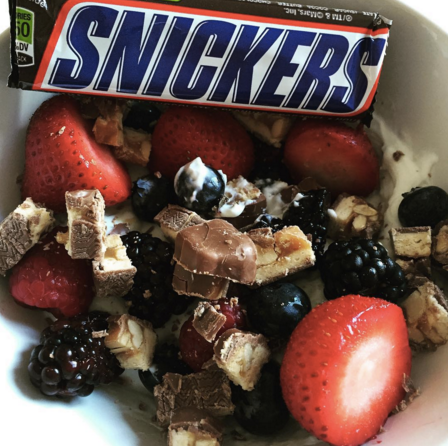
I aimed for a minimum of 30g protein for most meals to maximize muscle protein synthesis.
I honored my food cravings and shifted my nutrient timing and meal sizes to suit my lifestyle needs and maximize satiety. As prep wore on, I found myself unintentionally moving into an intermittent fasting style of eating, whereby I consumed my first meal at approximately 11am and my last meal at 7pm, totaling an eight-hour feeding window. I also found myself feeling more satisfied with three larger meals per day rather than four or more smaller meals.
Here is an example of how I was eating nine weeks out from my bikini show:
And how I was eating two weeks out:
Results
Throughout the duration of this 10-week experiment, I lost a total of 5.2lbs off the scale and 2 inches off my waist, dropping from 110.8lbs to 105.6lbs and 25.0 inches to 23.0 inches, respectively.
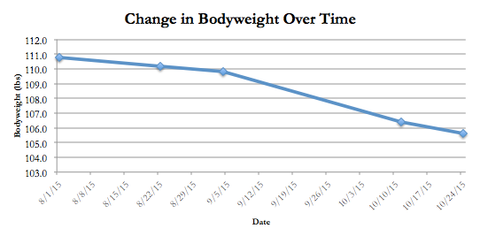
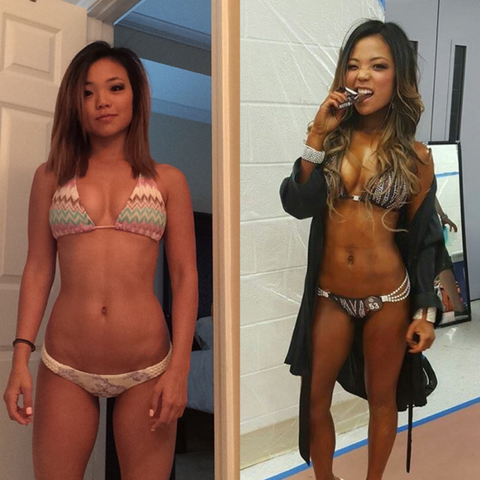
On October 24, 2015, I stepped on stage in the bikini at OCB Nationals, a national-level drug-tested bodybuilding competition. I won my height class and thereby earned my IFPA pro card.

I also got bloodwork done as soon as I was done with the show to see where my health markers were standing. The results are shown below.


Discussion
As you can see from my starting progress picture shown above, I didn’t have much body fat to lose to begin with to be stage-ready. The point, however, was not to lose as much fat as possible, but rather, to show that it’s entirely possible to improve body composition while eating some junk food so long as overall nutrition is managed.
Throughout the contest prep, I was able to retain much of my strength in the gym. While my squat strength diminished the most, my deadlift, bench, and hip thrust strength dropped marginally, and my chin-up strength increased.
What’s interesting to note that, though I did lose an inch of size around my hips, I was able to attenuate further losses via the high volume glute training I performed multiple days per week. Had I not been proactive about maintaining as much glute size as possible, it’s likely that I would have lost far more size, as has been the case with previous contest preps.
I also came in at my all-time leanest body fat level. I was not able to get a DEXA scan done before or after the contest prep, but I would estimate that my body fat dropped from approximately 17% to 14%. (See related: Body Fat Pictures and Percentages by Leigh Peele)
I did not get bloodwork done at week 0, which would have been helpful in providing baseline numbers for comparison after eating 70 consecutive daily Snickers bars. However, as you can see from the images above, my lipid panel, insulin, and glucose are all currently within healthy ranges.
Dietary adherence throughout this experiment was above 95%, meaning that I consistently met my prescribed macronutrient numbers within 5g. Had I not controlled for my overall calorie intake, I could have easily not made any progress or even gained some bodyfat while eating my daily Snickers bar.
One note I’d like to make about this is that the last few weeks of my contest prep were excruciatingly difficult because each Snickers bar took up a good chunk of my calories per day. Clocking in at 4g protein, 33g carbohydrates, and 12g per bar, that totaled 250 calories that effectively ate up 20% of my allotted daily calories. I found myself feeling especially low-energy and drained in the final weeks leading up to my show, and I know that the diet would have been far easier had I been able to opt for another food that was less calorically-dense. Nevertheless, for the sake of this experiment, I pushed through. To view the full details of what and how much I ate every day, you can follow me on MyMacros+ under the username SoheeFit.
Conclusions
The objective of the Snickers Diet was not to encourage people to consume junk food on a regular basis, and by no means does anyone need to consume a Snickers bar (or any other specific junk food for that matter) everyday to lose fat. Rather, the purpose of this experiment was to drive home four points:
1. Junk food is not inherently fattening, and there is no such thing as a good or bad food.
It is absolutely possible to lose fat while regularly incorporating treats such as candy bars, ice cream, and cookies into your diet. Sugar gets a bad rap because it scores extremely low on the satiety index and it’s also highly palatable, which means it’s easy to overconsume.
Conversely, if consumed in excess, it is theoretically possible to gain body fat on nutrient-dense foods such as chicken breast and rice. Think about the last time you ate too much broccoli, though. Probably never happened, right?
Then, when people do enjoy treats such as chocolate cake, they tend to overindulge. However, what many fail to realize that it’s the excess calories and not the sugar itself that contributes to fat gain. Correlation does not equal causation.
Note Dr. Mark Haub’s Twinkie Diet from a number of years back in which, in similar fashion, the professor of human nutrition at Kansas State University shed 27lbs while eating convenience store foods.
2. Junk food consumed in moderation is not necessarily unhealthy.
I know there are many individuals out there who proclaim that junk food in any amount is artery-clogging – yet as my bloodwork shows, that is not the case. This is supported in the literature as well, whereby multiple studies suggest that consuming simple carbohydrates or complex carbohydrates affects neither body composition or blood lipids (Saris et al., 2000; Surweit et al., 1997).
Unless you have a specific intolerance or allergy, judicious quantities of junk food are harmless in the grand scheme of things.
3. Total calorie intake matters for body composition far more than specific food choices.
It’s the law of thermodynamics in action. When there is an energy surplus, weight is gained because the energy must be stored; when there is an energy deficit, weight is lost as the body oxidizes bodily tissue (Wardlaw & Kessel, 2002).
Granted, the topic is a little more complex than that, and the specific details are beyond the scope of this article. Suffice to say that there are various factors, including fiber and the thermic effect of food (with protein having the highest thermic effect at 25-30%) that influence the calories-in-calories-out equation (Halton & Hu, 2004). The case still stands, however, that total calories, at the end of the day, will determine whether weight is gained, lost, or maintained.
4. Incorporating a small quantity of junk food into your diet can help increase dietary adherence, which will in turn yield better fat loss results.
This last point is the beauty of flexible dieting.
The best way to ensure that you stick to a nutrition program is to actually enjoy it. It’s important, then, to be honoring your unique food preferences and factoring that into your day. For some people, that’s going to mean Poptarts and cookies; for others, it may be grilled cheese and french fries. If these foods can increase dietary adherence by nipping cravings in the bud before they get out of control, then total calories will be kept in check consistently over time, which we’ve established as the most important factor in weight gain vs. weight loss.
Obviously, the daily Snickers bar was an extreme case of flexible dieting used to illustrate a bigger picture. And while junk food is not mandatory per se to achieve results, it just so happens that we humans happen to have a strong affinity for high sugar, high fat goodies. It would be prudent to make that way work for us rather than against us.
Please don’t misunderstand me: This is not to say that you can achieve optimal health by fitting in only junk food into your diet and fitting your macros. Here’s an excellent video by Eric Helms discussing the nutrition hierarchy:
Since everyone’s been asking: For now, I’m very much enjoying fitting other treats into my diet, like my good ‘ole mini chocolate chips, grilled cheese sandwiches, and Lucky Charms cereal. Consuming any treat for 70 straight days is bound to get tiring after a while, and this scenario was no exception.

To learn more about fitting treats into your diet while still working your way toward your fitness goals, check out my product, The Beginner’s Guide to Macros. This e-book teaches you the practical tools you need to lose fat while still enjoying your life.
Let me teach you how to have your cake and eat it, too – literally!
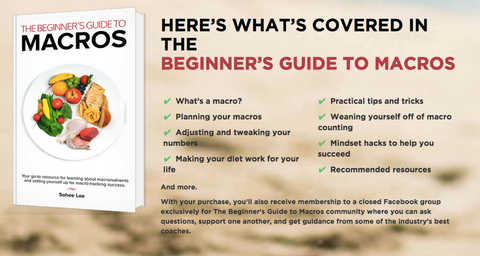
References
Halton, T.L., & Hu, F.B. (2004) The effects of high protein diets on thermogenesis, satiety and weight loss: a critical review. J Am Coll Nutr., 23(5):373-85.
Hunter, G.R., Byrne, N.M., Sirikul, B., Fernandez, J.R., Zuckerman, P.A., Darnell, B.E., & Gower, B.A. (2008) Resistance training conserves fat-free mass and resting energy expenditure following weight loss. Obesity (Silver Spring), 16(5):1045-51.
Saris, W.H., Astrup, A., Prentice, A.M., Zunft, H.J., Formigueera, X., Verboekte-van de Venne, W.P., Raben, A., Poppitt, S.D., Seppelt, B., Johnston, S., Vasilaras, T.H., & Keogh, G.F. (2000). Randomized controlled trial of changes in dietary carbohydrate/fat ratio and simple vs complex carbohydrates on bodyweight and blood lipids: the CARMEN study. Int J Obes Relat Metab Disord, 24(1):1310-8.
Surwit, R.S., Feinglos, M.N., McCaskill, C.C., Clay, S.L., Babyak, M.A., Brownlow, B.S., Plaisted, C.S., & Lin, P.H. (1997.) Metabolic and behavior effects of a high-sucrose diet during weight loss. Am J Clin Nutr, 65(4):908-15.
Wardlaw, G.M., & Kessel, M. (2002). Energy Production and Energy Balance. In: Perspective in Nutrition 2nd Ed., New York, NY. p. 535-7.



